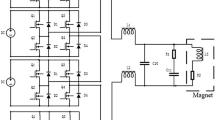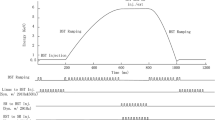Abstract
Objective
HEPS is a fourth-generation photon source under construction. HEPS adopts the magnetic focusing structure of 7BA, and the beam dynamics aperture is very small. HEPS injection scheme adopts the on-axis injection scheme. To minimize perturbation on adjacent bunches during on-axis swap out injection, a set of superfast kicker and high-voltage fast pulse power supply are needed. The high-voltage fast pulse power supply uses pulsed power stacking technologies, and the power supply needs the multichannel and low jitter clock signal. Therefore, it is necessary to develop a precise clock source.
Method
The clock source adopts FPGA controller with full digital control, and the output pulse mode of the system can be adjusted in real time. A detection module based on program control is used to check repetition rate and bottom width of input clock and output clock in real time. High-speed and precision clock signal output circuit is used to guarantee signal integrity and reduce clock signal jitter.
Conclusion
The prototype experiment proves that the output clock can well meet requirements of design. The minimum bottom width of the independent clock is 5 ns, the minimum time interval of the two groups of clocks is 5 ns, and the jitter of output clock is lower than 50 ps. The developed clock source can well meet the application requirements of high-voltage fast pulse power supply in HEPS injection system.














Similar content being viewed by others
References
P Liu 2020 Fast corrector power supply design for HEPS Radiat. Detect. Technol. Methods 4 1 56 62
P Liu FL Long 2020 A precision ADC sampling system design Radiat. Detect. Technol. Methods 4 2 182 189
Y. Jiao et al., in Accelerator Physics studies for the High Energy Photon Source in Beijing, Proc. FLS2018, MOP2WB01 Shanghai, China (2018)
Y Jiao 2018 Performance comparison of different ultralow emittance unit cells Phys.: Conf. Ser. 1067 032004
Y Jiao 2018 The HEPS project Synchrotron Rad. 25 1611 1618
Y Jiao G Xu 2017 Optimizing the lattice design of a diffraction-limited storage ring with a rational combination of particle swarm and genetic algorithms Chin. Phys. C 41 2 027001
Y. Jiao et al, in Progress of Lattice Design and Physics Studies on the High Energy Photon Source, IPAC'19, Melbourne, Australia
Z. Duan et al., in The Swap-Out Injection Scheme for the High Energy Photon Source, Proc. IPAC’18, THPMF052, Vancouver, Canada (2018)
Z. Duan et al., in Simulation of the Injection Efficiency for the High Energy Photon Source, presented at IPAC’19, Melbourne, Australia, May 2019, paper TUPGW048, this conference (2019)
Z. Duan et al., in Simulation of the injection transient instability for the High Energy Photon Source, presented at IPAC’19, Melbourne, Australia, May 2019, paper TUPGW053, this conference (2019)
XM Jiang 2014 Chinese high energy photon source and the test facility (in Chinese) Sci. Sin.-Phys. Mech. Astron. 44 1075 1094 https://doi.org/10.1360/SSPMA2014-00158
JH Chen 2019 Strip-line kicker and fast pulser R&D for the HEPS on-axis injection system Nuclear Inst. Methods Phys. Res. A 920 1 6 https://doi.org/10.1016/j.nima.2018.12.009
Intel® MAX® 10 FPGA Design Guidelines (Intel, USA, 2020)
Author information
Authors and Affiliations
Corresponding author
Rights and permissions
About this article
Cite this article
Peng, L., Guanwen, W., Jinhui, C. et al. A precision clock source design. Radiat Detect Technol Methods 5, 238–244 (2021). https://doi.org/10.1007/s41605-020-00234-5
Received:
Revised:
Accepted:
Published:
Issue Date:
DOI: https://doi.org/10.1007/s41605-020-00234-5




